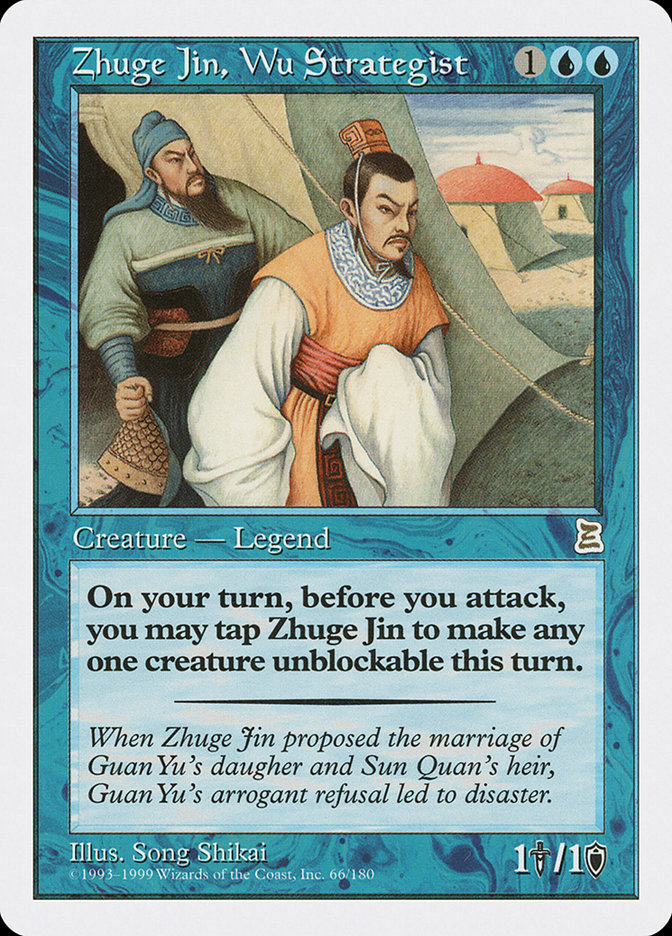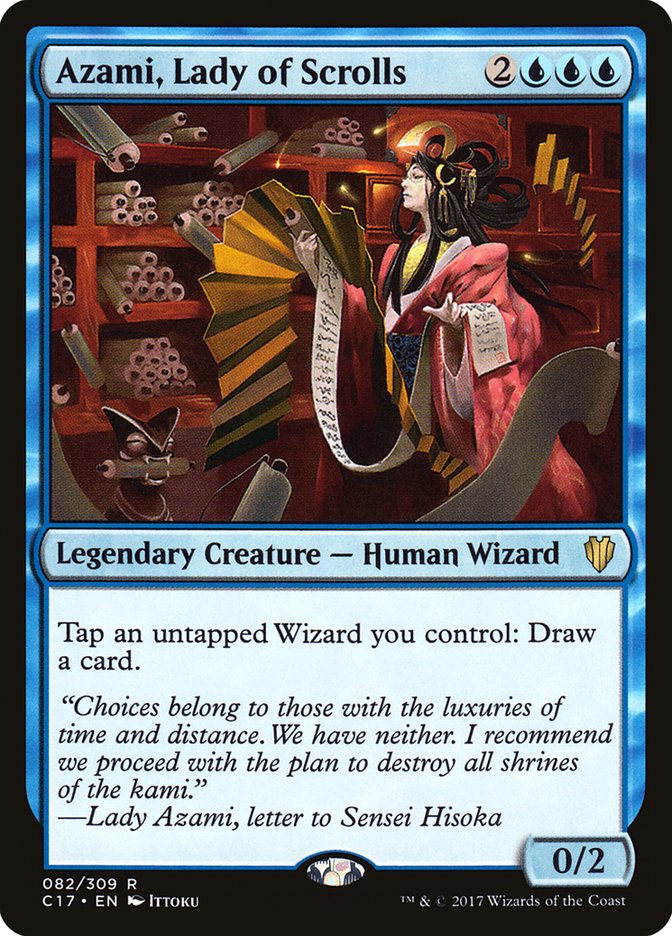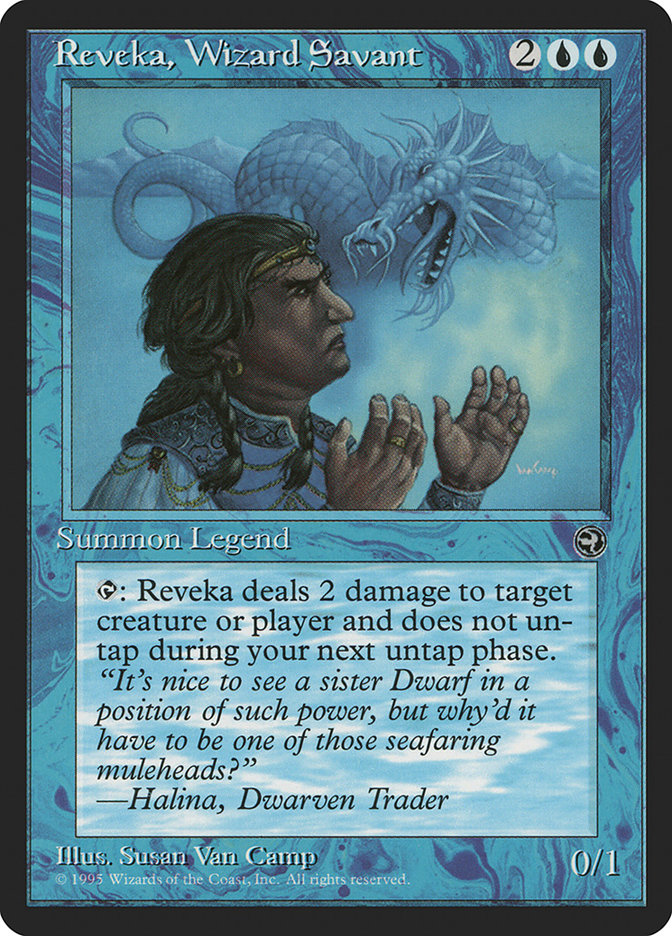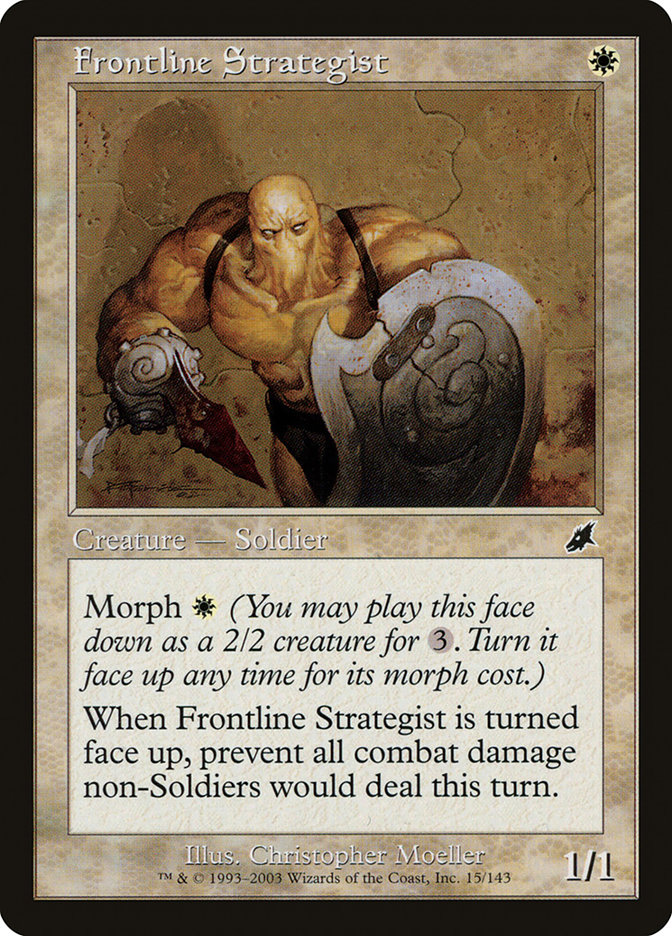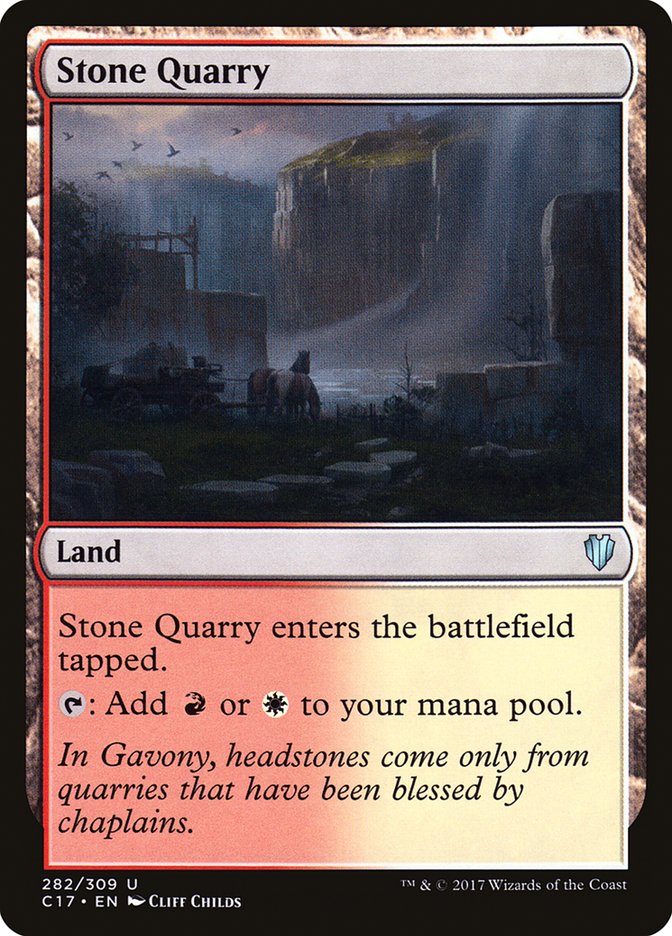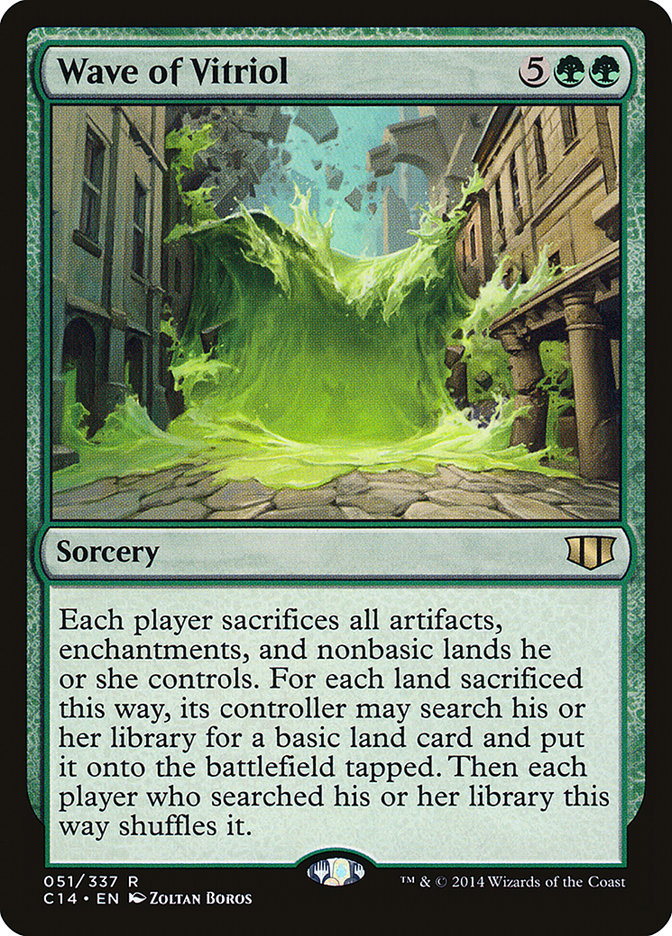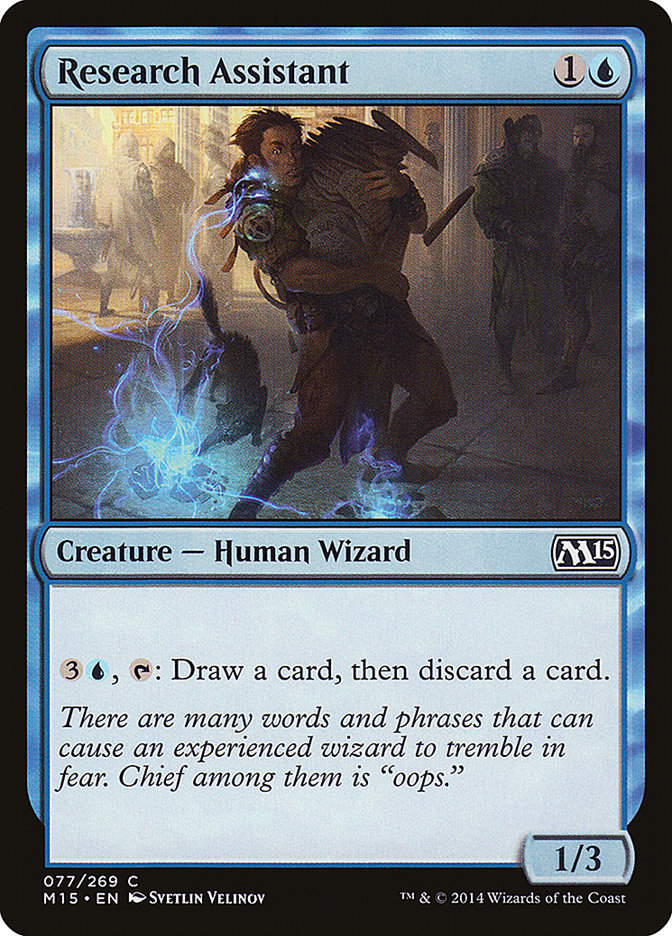It’s my observation that we don’t think enough about how we think. We do things, and we think through how we might do them (“What’s the best line of play here?” is a good example), but we don’t proactively break down our thought processes beforehand. To that end, I’d like to explore the process of deckbuilding for Commander. I want to talk about not just how I approach it, but consider other methodologies as well, and some of the tools we can use to enhance our process.
Right now you’re probably saying, “Well, just build the deck.” But it’s never that simple, is it? One of the main issues in the process is deciding from the start if you’ll be either designing while you assemble or assembling after you’ve designed. Both ways certainly have their own merits.
Design While Assembling
I call this the “splatter approach,” in which you figure out along the way what you’ll be doing. Even then, there’s more than one way to do it. The really splattery way to do it is to not have an idea in mind and then just finding what’s out there. This method usually comes from grabbing a box of cards and rifling through it, with the requisite Oooh, that’s a cool card!” along the way. The second is having the inkling of an idea what you want to explore before grabbing the box.
There are two basic foundations here. The first, unique to the Commander format, is starting with a commander. You see a legendary creature and your mind jumps to the thought that you’d like to play the card; in the splatter approach, you don’t really know what it is that you’d like to do with that commander, just that you want to play it. You start looking for things that might go with it. It’s fascinating to me that, for this method, physically picking up cards and looking through them seems better than doing any kind of online search. The eye-hand connection (at least for me, and I’m guessing there are many of you just like me in this regard) divulges more information than the eye-screen connection does. I feel like I get a better sense of what a card will do if I’m looking at it in the form in which I’ll play it. It’s probably obvious from that statement that I play predominantly paper Magic; I’m curious as to whether the answer is different for the folks who play mostly online.
The second foundation is beginning with a general theme or strategy. Themes can be broad. The most popular is tribal; everyone has a favor Magic creature type. Themes might also be more esoteric, like using only cards that start with your initials or describing the cast of a favorite piece of literature. Strategies include choosing to either go high with a few giant creatures or wide with lots of smaller ones. Strategies might also include specific Magic abilities, especially the kind we find in keywords. You might think that islandwalk is the best ability ever (here’s looking at you, River Boa) or have a fondness for banding (if you actually have a fondness for banding, I suggest seeking professional guidance).
Voltron, or assembling one massive creature, is also a strategy; it’s most popularly used with a commander so that you can get a commander damage kill in one or two shots. The splatter approach is still the same here; you pick up the box of cards wanting to find cool things that will make your commander bigger and fatter. You can start with an obvious commander, like Uril, the Miststalker; I’ll suggest thinking way outside the box and starting with one that you wouldn’t normally think about getting commander damage kills with. Adun Oakenshield or Zedruu, the Greathearted both come to mind. Something with a starting power of zer would be even more awesome. Not counting the ones with an asterisk for power or that enter the battlefield with counters, this includes Akiri, Line-Slinger; Azami, Lady of Scrolls; Doran, the Siege Tower (okay, that one’s a little cheaty); Jace, Vryn’s Prodigy; Reveka, Wizard Savant; and Skeleton Ship.
The splatter approach lets you figure out along the way what you want to do, without much regard to the details of how you’re going to do it. You’re not paying attention to mana curves or other technical bits, just running on intuition and feeling. Be warned, though; this is the one that’s most likely for you to end up with a giant pile of cards on the table. While not a bad thing in its own regard, just remember that you’re going to have to put back everything that you dragged out.
The splatter approach’s philosophy is that you don’t need a plan, just a goal. In general, it’s the more fun method, since it lets you explore instead of working to implement a plan. It’s very artsy.
Of course, having a plan going in is a fine idea in its own right.
Intelligent Design
There’s nothing better than appropriating an emotionally charged phrase for your own purposes, is there? Let’s call it something else, maybe just “design.”
The basics are the same. You can start with a commander, a strategy, or a theme—only this time, you’ll make a plan. You’ll actively use your knowledge of the cards legal in the format as your starting point. For example, if you know you want to build that Reveka, Wizard Savant Voltron deck, you probably already have a good idea of some of the Auras or Equipment you’ll want to use to make her huge, like Sword of Fire and Ice or Sword of Light and Shadow (pretty much the whole “Sword of” suite).
If you’ve played for a while, just randomly think of a theme right now. A bunch of cards which fit that theme will pop into your head. Sure, you’ll need to do some deeper thinking to fill out and finish a list, but your experience gives you a head start. Even if you don’t have a great deal of experience, you’ve seen some cards and will have a starting point.
Speaking of starting points, although it’s not really deckbuilding, starting with a Commander preconstructed deck is a great idea. Especially if you’re less experienced, the decks, which are getting better and better at being interesting and well-constructed, demonstrate the bones of what an intelligently-designed Commander deck looks like. They can be a little loose on the mana curve, but that’s just a thing for you to make smart changes on. They’re fun to adapt a few steps at a time, but they can also simply serve as a blueprint for you—or perhaps even a cautionary tale (about too many enters-the-battlefield-tapped lands).
If you’re going with the planned approach, you’ll want to use the various tools at your disposal to help put together a list. Although I haven’t used it myself, I have it on good authority that Tapped Out has quality deckbuilding tools. It’s a site that also has plenty of ideas for building decks if you want to borrow from other people. Of course, there’s always our own Deck List Database if you want to see what other folks are doing, to include the luminaries of the format (and by that, I mostly mean Bennie). EDH Rec doesn’t have deckbuilding tools, but it sure has lots of analysis engines.
I suppose here is where we should talk about “netdecking” versus “being original.” I’m not sure why other people care where you got the idea for building your deck. It’s yours, and you built it so you could have some fun, so it doesn’t really matter. Yes, original ideas are wonderful; it’s just that not all ideas have to be original in order to be worthwhile. So to the people who are critical of netdecking, I say stop being a hater. Mote in your own eye and all.
The online tool I use most is magiccards.info. Although it’s slower to update than Gatherer, I find the interface cleaner and the searches more useful. It seems to take fewer clicks and less typing to get the information I want. I’m not going to lie: the fact that you can click on Commander color identity at magiccards.info is a big plus in by book.
One of my own personal tools is a decklist template. It has a bunch of headings, and I just insert the names of cards. I keep promising myself that I’ll make a relational database so that I can then do lots of tricky stuff with it (like easily figure out what percentage of my decks have Solemn Simulacrum in them), but that promise is so far unfulfilled. What I work with now is just a Word document that looks like this:

Having three columns lets me see the whole deck at a single glance. At the bottom of the document, I also have a configuration control section, which I update every time I make a change (and that database could do for me). Here’s an example:
2017 22 Sep: In: Verdant Rebirth Out: Crypt Incursion
Having the list laid out in front of me in such a fashion also shows me when I have too many of one type of card (except creatures…you can never have too many creatures). It’s not necessarily bad to be tilted toward one kind of card; it’s just that you’ll want to know if you are. You wouldn’t want to put Wave of Vitriol into a deck with fifteen artifacts, ten enchantments, and 25 nonbasic lands, but if you discover that you don’t have many of the three, stuff Wave of Vitriol in. Primal Order also a fine card (although not yet available in foil).
The number of lands you play must be part of your design plan (because it determines how many nonlands you can play). Understanding how your deck operates will determine if you can be on the lower end or must be on the higher end. Personally, I always start with a baseline of 37 and adjust as required. I don’t often go below that, although in mono-color or even two-color decks, 35 or 36 have worked. If you absolutely need to hit a land drop every turn of the first seven to ten, you’ll want to go higher, even if you have some ramp.
Assembling After You’ve Designed (Intelligently)
I certainly have built decks without picking up a single physical card. It’s nice to be able to lean back at my desk, keyboard in my lap, and brew. Again, it doesn’t have the same kind of tactile sense, but there’s value in not having to put away cards after you’ve piled too many of them on the table. True story: I once wrote down the exact 100 cards for a deck. I then went to the card closet to pull them. I came back to my desk with 300 cards, because that one and that one and that one were really awesome. And this was in the format’s early days, somewhere around 2005 (why don’t we have a word like “somewhen?” I suppose “sometime” fits, but we should have “somewho” and “somewhy” as well). Think of how many cards I would have come back with today!
Having an in-place idea of how you’re going to consider tackling your objectives simply leaves you with a better plan. Whether it’s the splatter approach or a more detailed method is more up to how your particular brain works. You’ve picked your design method, you’ve used all the tools at your command, and you’ve sleeved up the cards (don’t forget “Do I have enough sleeves?” is also part of your plan). Now all you have to do is shuffle them up. Let’s hope your games are as good as your plan.
This week’s Deck Without Comment is Kresh Into the Red Zone.
Creatures (34)
Planeswalkers (1)
Lands (37)
Spells (28)

Check out our comprehensive Deck List Database for lists of all my decks:
SIGNATURE DECKS
Purple Hippos and Maro Sorcerers; Kresh Into the Red Zone; Halloween with Karador; Dreaming of Intet; You Did This to Yourself.
THE CHROMATIC PROJECT
Mono-Color
Heliod, God of Enchantments; Thassa, God of Merfolk; Erebos and the Halls Of The Dead; Forge of Purphoros; Nylea of the Woodland Realm; Karn Evil No. 9.
Guilds
Lavinia Blinks; Obzedat, Ghost Killer; Aurelia Goes to War; Trostani and Her Angels; Lazav, Shapeshifting Mastermind; Zegana and a Dice Bag; Rakdos Reimagined; Glissa, Glissa; Ruric Thar and His Beastly Fight Club; Gisa and Geralf Together Forever.
Shards and Wedges
Adun’s Toolbox; Angry, Angry Dinos; Animar’s Swarm; Borrowing Stuff at Cutlass Point; Ikra and Kydele; Karrthus, Who Rains Fire From The Sky; Demons of Kaalia; Merieke’s Esper Dragons; Nath of the Value Leaf; Rith’s Tokens; The Mill-Meoplasm; The Altar of Thraximundar; The Threat of Yasova; Zombies of Tresserhorn.
Four-Color
Yidris: Money for Nothing, Cards for Free; Saskia Unyielding; Breya Reshaped.
Five-Color
Partners
Tana and Kydele; Kynaios and Tiro; Ikra and Kydele.
THE DO-OVER PROJECT
Animar Do-Over; Glissa Do-Over; Karador Do-Over; Karador Version 3; Karrthus Do-Over; Kresh Do-Over; Steam-Powered Merieke Do-Over; Lord of Tresserhorn Do-Over; Mimeoplasm Do-Over; Phelddagrif Do-Over; Rith Do-Over; Ruhan Do-Over.
If you’d like to follow the adventures of my Monday Night RPG group (in a campaign that’s been alive since 1987) which is just beginning the saga The Lost Cities of Nevinor, ask for an invitation to the Facebook group “Sheldon Menery’s Monday Night Gamers.”


